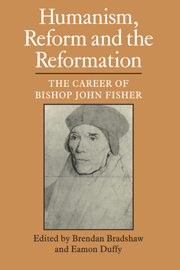Book contents
- Frontmatter
- Contents
- Preface
- List of abbreviations
- Bishop John Fisher, 1469–1535: the man and his work
- John Fisher and the promotion of learning
- The University chancellor
- The bishop in his diocese
- Fisher and Erasmus
- Fisher and More: a note
- The polemical theologian
- Fisher's view of the Church
- Fisher, Henry VIII and the Reformation crisis
- Royal ecclesiastical supremacy
- The spirituality of John Fisher
- Appendixes
- Index
The spirituality of John Fisher
Published online by Cambridge University Press: 04 August 2010
- Frontmatter
- Contents
- Preface
- List of abbreviations
- Bishop John Fisher, 1469–1535: the man and his work
- John Fisher and the promotion of learning
- The University chancellor
- The bishop in his diocese
- Fisher and Erasmus
- Fisher and More: a note
- The polemical theologian
- Fisher's view of the Church
- Fisher, Henry VIII and the Reformation crisis
- Royal ecclesiastical supremacy
- The spirituality of John Fisher
- Appendixes
- Index
Summary
St John Fisher's place in the history of English spirituality, like his place in the history of English humanism, is obscured by problems of definition. So austere a figure challenges expectations derived from the identification of the cause of the new learning (and the new piety) with Erasmus. Historians have therefore been tempted to describe his relation to the movements of the early sixteenth century in terms of contrast, rather than participation. Whether the polarities employed are those of ‘medieval’ as opposed to ‘Renaissance’, or ‘unreformed’ as opposed to ‘reformed’, the temptation is to opt for a single all-purpose descriptive category. C. S. Lewis, in what remains the most helpful brief account of Fisher as a religious writer, succumbs to temptation on both scores. Fisher, he claimed, ‘is almost a purely medieval writer, though scraps of what may be classified as humanistic learning appear in his work’, but ‘he matters less as a literary figure than as a convenient representative of the religion in possession at the very beginning of the English Reformation. He was a bishop and died for his faith: in him we ought to find what men like Tyndale were attacking.’ For a mere historian to quarrel with Lewis about a matter of literature might seem as foolhardy as the attempt to anatomise the spirituality of a saint. Yet one may well feel that in Lewis's easy contrasts something has been omitted. It does not seem very useful to characterise any one figure as ‘representative’ of so complex a reality as late-medieval English religion.
- Type
- Chapter
- Information
- Humanism, Reform and the ReformationThe Career of Bishop John Fisher, pp. 205 - 232Publisher: Cambridge University PressPrint publication year: 1989
- 2
- Cited by



